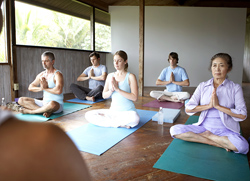Everyone has to find his peace from within . . . and peace, to be real, must be unaffected by outside circumstances.
—Everyone has to find his peace from within . . . and peace, to be real, must be unaffected by outside circumstances.
Mental relaxation techniques form an important part
of your stress “armoury”. Used in conjunction with techniques like deep
breathing, they are a powerful method of calming your reaction to
stressful situations.
Use Imagery to Relax
Imagery is a potent
method of stress reduction, especially when combined with physical
relaxation methods such as deep breathing. The principle behind imagery
is that you can use your imagination to recreate, and enjoy, a relaxing
situation. The more intensely you imagine the situation, the more
relaxing the experience will be. You can use imagery to prepare for a
big event, rehearsing mentally and practising in advance for anything
unusual that might occur. Imagery also allows you to pre-experience
achievement of your goals to boost your self-confidence. This is a
technique that is used by successful athletes.
Techniques to Practise
One common use of imagery in relaxation is to
imagine a scene or event that you remember as safe, peaceful, and happy.
When you are under pressure, sit down in a quiet place, and recall your happy memory.
Bring all your senses into the image with, for example, sounds of
running water and birds, the smell of cut grass, the warmth of the sun.
Use this happy, beautiful place as a retreat from stress and pressure.
Imagine all of your stress, distractions, and ordinary, everyday concerns flowing out of your body.
Meditate Stress Away
By relaxing your body
and focusing your thoughts on one thing for a sustained period, your
mind is occupied and diverted from the problems that are causing you
stress. This gives your body time to relax and recuperate, and to clear
away any stress hormones. Begin by sitting quietly and comfortably.
Relax your muscles, starting with your feet and working up your body,
then use one of the following methods of focusing your concentration:
Focus on your breathing – With your eyes closed, breathe in deeply and then let your breath out. Do this for ten or 20 minutes.
Focus on an object – Focus your entire attention on an object – its shape, colour differences, texture, temperature, and movement.
Focus on a mental image – This can be a very refreshing way to meditate. Here, you create a mental image of a pleasant and relaxing place.
It is important to keep
your attention focused. If external thoughts or distractions wander into
your mind, let them drift out until you can focus your mind again.
If you find it difficult to get yourself started on meditation, join
a meditation class to learn the basic techniques and then use them in
your daily life.

Use Self-Hypnosis
Hypnosis has a dubious image,
but it is a useful tool for achieving deep relaxation. Like meditation,
self-hypnosis helps you to relax your body, allows stress hormones to
subside, and distracts your mind from unpleasant thoughts. The
relaxation achieved with self-hypnosis can be intense. Together with
meditation and imagery, self-hypnosis can be used as part of a
comprehensive daily stress management routine.
Use Affirmations
Unlike meditation,
self-hypnosis can be combined with affirmations (positive statements) to
manage stress and build self-confidence. If you want to use positive
affirmations, prepare them before you start the session, as you will not
want to think about them once you have achieved a state of deep
relaxation.
Techniques to Practise
The two principal elements of self-hypnosis are relaxation and suggestion.
Once you have relaxed your body you can utilize the power of
suggestion to deepen your state of relaxation, introducing affirmations
to your suggestion, if you believe that this will be beneficial.
Begin by finding somewhere comfortable and quiet, and sitting
down. Close your eyes, and imagine waves of relaxation running through
your body from your scalp downwards, washing out any stress you feel.
Use suggestion to deepen the state of relaxation. This can be as
simple as saying, “I am feeling relaxed and comfortable” to yourself, or
you might use the traditional approach of telling yourself that you are
tired and sleepy.
Once you feel completely relaxed, mix in the affirmations you have prepared with the relaxation suggestions.
Use Bio-Feedback
Imagery and other relaxation techniques can be shown to work by using biofeedback devices.
These are electronic sensors that measure indicators of your stress
levels, such as the electrical conductance of your skin, and feed them
back as a dial reading or an audible signal.
This enables you to observe for yourself the real effect of these relaxation techniques.
By imagining pleasant and unpleasant scenes, for example, you can
actually see or hear the levels of stress in your body decreasing or
increasing.
Let Sound Relax You
NOTE
There’s a relaxation technique to suit everyone
Imagery,
meditation, and self-hypnosis are all active mental techniques that
require concentration. An alternative, and equally valid, approach is to
listen to calming music, or to pre-recorded relaxation MP3s or hypnosis
CDs. It requires no effort to listen to these, and this may be very
welcome at the end of a long, hard day’s work. If you commute by public
transport, try listening to them on a personal stereo as you travel home
from work. Soothing music and natural sounds can also be used to
accompany the more active relaxation methods discussed here. You can buy
relaxing music in many places, including several specialist websites,
but an alternative approach is to record tapes for yourself and develop
routines tailored to your needs.
Tip
Don’t use sound as a source of relaxation when you’re driving – you need to stay alert!